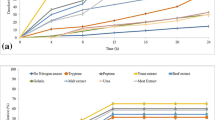Abstract
Melanoidins, complex biopolymer of amino-carbonyl compounds are the major coloring and polluting constituents of distillery wastewaters. In this study, three aerobic melanoidin-degrading bacteria (RNBS1, RNBS3 and RNBS4) were isolated from soil contaminated with distillery effluent and characterized as Bacillus licheniformis (RNBS1), Bacillus sp. (RNBS3) and Alcaligenes sp. (RNBS4) by biochemical tests and 16S rRNA gene sequence analysis. The degradation of synthetic and natural melanoidins was studied by using the axenic and mixed bacterial consortium. Results have revealed that the mixed consortium was more effective compared to axenic culture decolorizing 73.79 and 69.83% synthetic and natural melanoidins whereas axenic cultures RNBS1, RNBS3 and RNBS4 decolorized 65.88, 62.56 and 66.10% synthetic and 52.69, 48.92 and 59.64% natural melanoidins, respectively. The HPLC analysis of degraded samples has shown reduction in peak areas compared to controls, suggesting that decrease in color intensity might be largely attributed to the degradation of melanoidins by isolated bacteria.





Similar content being viewed by others
References
Addleman K, Dumonceaux T, Paice MG, Bourbonnais R, Archibald FS (1995) Production and characterization of Trametes versicolor mutants unable to bleach hard wood kraft pulp. Appl Environ Microbiol 61:3687–3694
Agarwal CS, Pandey GS (1994) Soil pollution by spent wash discharge: depletion of manganese (II) and impairment of its oxidation. J Environ Biol 15:49–53
Altschul SF, Madden TL, Schaffer AA, Zhang J, Zhang Z, Miller W, Lipman DJ (1997) Gapped BLAST and PSIBLAST: a new generation of protein database search programs. Nucleic Acids Res 25:3389–3402. doi:10.1093/nar/25.17.3389
Arora DS, Chander M, Gill PK (2002) Involvement of lignin peroxidase, manganese peroxidase and laccase in degradation and selective ligninolysis of wheat straw. Int Biodeterior Biodegradation 50:115–120. doi:10.1016/S0964-8305(02)00064-1
Barrow GI, Feltham RKA (1993) Cowan and steel’s manual for the identification of medical bacteria, 3rd edn. Cambridge University Press, Cambridge
Bernardo EC, Egashira R, Kawasaki J (1997) Decolorization of molasses wastewater using activated carbon prepared from cane bagasse. Carbon 35:1217–1221. doi:10.1016/S0008-6223(97)00105-X
Cammerer B, Kroh LW (1995) Investigation of the influence of reaction conditions on the elementary composition of melanoidins. Food Chem 53:55–59. doi:10.1016/0308-8146(95)95786-6
Chandra R, Bharagava RN, Rai V (2008) Melanoidins as major colourant in sugarcane molasses based distillery effluent and its degradation. Bioresour Technol 99:4648–4660. doi:10.1016/j.biortech.2007.09.057
Gonzalez T, Terron MC, Yague S, Junca H, Carbajo JM, Zapico EJ, Silva R, Cuenca AA, Tellez A, Gonzalez AE (2008) Melanoidin-containing wastewaters induce selective laccase gene expression in the white-rot fungus Trametes sp. I-62. Res Microbiol 159:103–109
Ghosh M, Ganguli A, Tripathi AK (2002) Treatment of anaerobically digested distillery spentwash in a two-stage bioreactor using Pseudomonas putida and Aeromonas sp. Process Biochem 37:857–862. doi:10.1016/S0032-9592(01)00281-3
Kapley A, Lampel K, Purohit HJ (2001) Rapid detection of Salmonella in water samples by multiplex PCR. Water Environ Res 73:461–465. doi:10.2175/106143001X139515
Kumar P, Chandra R (2006) Decolorization and detoxification of synthetic molasses melanoidins by individual and mixed cultures of Bacillus sp. Bioresour Technol 7:2096–2102. doi:10.1016/j.biortech.2005.10.012
Mercer DK, Iqbal M, Miller PGG, McCarthy AJ (1996) Screening actinomycetes for extracellular peroxidase activity. Appl Environ Microbiol 62:2186–2190
Mester T, Field JA (1997) Optimization of manganese peroxidase production by the white rot fungus Bjerkandera sp. strain BOS55. FEMS Microbiol Lett 155:161–168. doi:10.1111/j.1574-6968.1997.tb13873.x
Migo VP, Del Rosario EJ, Matsumura M (1997) Flocculation of melanoidins induced by inorganic ions. J Ferment Bioeng 83:287–291. doi:10.1016/S0922-338X(97)80994-4
Miyata N, Mori T, Iwahori K, Fujita M (2000) Microbial decolorization of melanoidins containing wastewaters: combined use of activated sludge and the fungus Coriolus hirsutus. J Biosci Bioeng 89:145–150. doi:10.1016/S1389-1723(00)88728-9
Mohana S, Desai C, Madamwar D (2007) Biodegradation and decolorization of anaerobically treated distillery spentwash by a novel bacterial consortium. Bioresour Technol 98:333–339. doi:10.1016/j.biortech.2005.12.024
Narde G, Kapley A, Purohit HJ (2004) Isolation and characterization of Citrobacter strain HPC 255 for broad range substrate specificity for chlorophenol. Curr Microbiol 48:419–423. doi:10.1007/s00284-003-4230-2
Ohmomo S, Itoh N, Wantanabe Y, Kaneko Y, Tozawa Y, Udea K (1985) Continuous decolorization of molasses wastewater with mycelia of Coriolus versicolor Ps4a. Agric Biol Chem 49:2551–2555
Ohmomo S, Daengsabha W, Yoshikawa H, Yui M, Nozaki K, Nakajima T, Nakamura I (1988) Screening of anaerobic bacteria with the ability to decolorize molasses melanoidins. Agric Biol Chem 57:2429–2435
Pant D, Adholeya A (2007) Biological approaches for treatment of distillery wastewater: a review. Bioresour Technol 98:2321–2334. doi:10.1016/j.biortech.2006.09.027
Reynolds TM (1968) Chemistry of nonenzymatic browning I. The reaction between aldoses and amines. Adv Food Res 12:1–52
Sirianuntapiboon S, Phothilangka P, Ohmomo S (2004) Decolorization of molasses wastewater by a strain no. BP103 of acetogenic bacteria. Bioresour Technol 92:31–39. doi:10.1016/j.biortech.2003.07.010
Tamura K, Dudley J, Nei M, Kumar S (2007) MEGA4: Molecular evolutionary genetics analysis (MEGA) software version 4.0. Mol Biol Evol 24:1596–1599. doi:10.1093/molbev/msm092
Yaylayan VA, Kaminsky E (1998) Isolation and structural analysis of maillard polymers: caramel and melanoidins formation in glycine/glucose model system. Food Chem 63:25–31. doi:10.1016/S0308-8146(97)00237-9
Acknowledgments
The financial assistance received by Mr. R. N. Bharagava, SRF from University Grants Commission and CSIR Network project (NWP-19), New Delhi is gratefully acknowledged.
Author information
Authors and Affiliations
Corresponding author
Rights and permissions
About this article
Cite this article
Bharagava, R.N., Chandra, R. & Rai, V. Isolation and characterization of aerobic bacteria capable of the degradation of synthetic and natural melanoidins from distillery effluent. World J Microbiol Biotechnol 25, 737–744 (2009). https://doi.org/10.1007/s11274-008-9944-7
Received:
Accepted:
Published:
Issue Date:
DOI: https://doi.org/10.1007/s11274-008-9944-7




